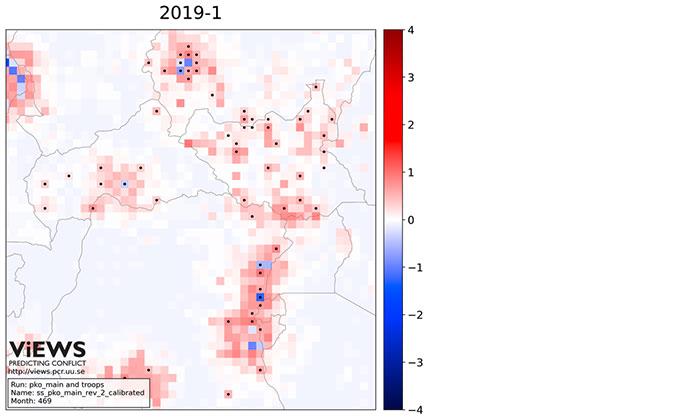Unpacking how peacekeeping affects violence – what the data can tell us
Applying digital technologies to help run a mission and be accountable | Lisa HultmanFor peacekeeping to be successful, it is essential to evaluate the impact of peacekeeping activities on the conflict dynamics. There are two reasons for this. First, for the mission itself, it provides an understanding of how to prioritize and best make use of limited resources. Thorough analysis can aid the planning and make peacekeeping more effective. Second, in UN headquarters, it provides an argument for policy makers for why they should fund peacekeeping. Spending money on peacekeeping makes sense only if peacekeeping actually works to enhance security, since this is often one of the main tasks. Therefore, objective analyses of how peacekeeping works are of great political relevance. Any such assessment of the efficiency of peacekeeping requires data. Our conclusions are never better than the data we base them on.
Mapping peacekeeping deployments and capacities
The first type of data we need for the purpose of analyzing the impact of peacekeeping is reliable data on peacekeeping itself. But how do we measure peacekeeping? This is an open question that scholars still debate. However, one relevant question to begin with is whether the number of peacekeepers deployed is associated with less violence. (Indeed, there are other important goals that peacekeeping operations work towards, but here I choose to focus only on security). In other words, does greater peacekeeping capacity on the ground enable missions to carry out their mandated task of reducing violence? For policy makers, this translates into the following question: does spending money on peacekeeping improve security?
For policy makers, this translates into the following question: does spending money on peacekeeping improve security?
One useful resource for this purpose is the Geocoded Peacekeeping (Geo-PKO) Dataset. It is based on official UN deployment maps, allowing users to analyze peacekeeping dynamics at various levels of analysis. It provides data on the number of troops deployed by location, the type of units and the troops contributing countries, the presence of police units and observers, and the location of headquarters,. We can thus plot the number of peacekeepers by location and compare those across missions are over time. If we are interested in exploring particular types of peacekeeping units—for example, the aviation capacity available to missions—we can also plot locations with aviation or helicopter support in relation to number of troops. Figure 1 shows these data for Northern and Central Africa and parts of the Middle East in 2019.
Figure 1 | Summary of deployments in 2019
(Source: Geo-PKO Dataset 2.0)
Detailed data on the characteristics of troop deployments are useful if we want to understand which aspects of peacekeeping missions contribute most to improving security. It provides a measure that is comparable across missions, and over time. These data can also show differences in how missions station their troops. MINUSCA (Central African Republic) displays rather static deployments, slowly deploying more troops and covering more locations. UNMISS (South Sudan), in contrast, redeploys troops more frequently.
Mapping violence beyond UN presence
The second type of data we need concerns conflict violence. One such source comes from the missions themselves. As described by Allard Duursma and John Karlsrud in another contribution to this site, the UN is improving its data collection from the field. However, while this is an important development, it is not sufficient. There is a risk that the UN focuses on collecting detailed data on all their interactions with civilians and armed actors, while at the same time overlooking a crucial component for evaluating peacekeeping effects: the comparison with areas where the UN is not active. As noted by Duursma and Karlsrud, UN data will be more complete in areas where peacekeepers are present.
There is a risk [of] overlooking a crucial component for evaluating peacekeeping effects: the comparison with areas where the UN is not active.
Why is this a problem? In social science, we talk about this as ‘selection bias’. In short, it means that if the UN is doing its job in responding to violence – and thereby “selecting itself” into the most challenging situations – we will draw biased conclusions if we only observe those settings. We must compare those peacekeeping sites to similar locations where peacekeepers are not present. Only then can we address the important question of whether peacekeeping improves security/is effective.
We therefore need to analyze conflict data that are collected irrespective of UN presence. The Uppsala Conflict Data Program is one such publicly available data source. They base their data collection on a variety of written sources, such as news articles and human rights reports. While not a perfect representation of all political violence (under-reporting is always a potential problem when we map armed conflict), it is systematically collected both where UN peacekeepers operate and where they are absent.
Exploring the effectiveness of peacekeeping
With data on both peacekeeping deployments and conflict violence, we can explore a number of questions that are relevant both from an academic point of view and from a more practical perspective.
For example, do peacekeepers locate to areas where civilians are targeted by armed actors? One study addresses this question with disaggregated data on violence and peacekeeping presence: it shows that the UN respond to rebel violence against civilians. However, there is no such observable pattern of responding to government violence against civilians. This raises questions of how missions balance the mandated tasks of protecting civilians and the political relationship with the host state.
Another question is whether the presence of peacekeepers effectively reduces the intensity of violence in their areas of operation. We can study this with traditional methods, for example analyzing the correlation between the number of peacekeepers in a location and the level of violence. Several studies have demonstrated such a violence-reducing effect of peacekeeping. Detailed data allow us to take this finding one step further and explore more nuanced consequences of peacekeeping. For example, whether the local composition of the peacekeeping units matter for their effectiveness, or whether similar peacekeeping deployments lead to different outcomes depending on local contextual factors.
The conjecture is that if peacekeeping is an important factor influencing violence, data on peacekeeping should be able to predict the violence in an area.
We can also utilize more advanced methods: training a model with peacekeeping and violence, and then evaluating its predictive power out of sample (for example for another time period than the one used to train the model). The conjecture is that if peacekeeping is an important factor influencing violence, data on peacekeeping can be utilized to predict violence in an area. And if it does, such a model can improve general forecasting of violence. Forecasting and early-warning systems have become important tools for both policy makers and humanitarian organizations. Academics can offer models that are not only methodologically sophisticated, but also informed by theory. One example is the Violence Early Warning System (ViEWS) project at Uppsala University.
A recent study explores the utility of incorporating local data on peacekeeping deployments in a prediction framework. Figure 2 illustrates this. Here we see the location of UN peacekeepers marked with black dots. The color scheme reflects the predicted escalation or de-escalation of violence four months later. The model is trained to predict how peacekeeping, in conjunction with other relevant variables, influences violence. We have evaluated the accuracy of the model by comparing to the true changes in violence. Our analysis suggest that the model correctly predicts the de-escalation of violence in areas where peacekeepers are present. Even though some locations are predicted to see an increase in violence (driven by other factors), data on peacekeeping helps to identify de-escalation. This is because peacekeepers on average help to suppress violence.
Figure 2 | Predicted changes in conflict violence and location of UN peacekeepers
(partly based on the analysis in “Employing Local Peacekeeping Data to Forecast Changes in Violence”, unpublished paper by Lisa Hultman, Maxine Leis, and Desirée Nilsson.)
How general data can help address the mission-specific
Can we really learn anything useful by using general data, without considering the unique situation in each mission and the particular challenges they face? I believe so. While mission analysts have crucial local knowledge and can assess the complexity of a concrete situation, academics are trained to employ sophisticated methods and systematically test various hypotheses. The data approach I have argued for here is therefore an important complement to the peacekeeping organizations’ own analyses. The fundamental question – does peacekeeping work? – requires a general approach beyond analyzing individual cases. While each mission has to understand the unique circumstances of how to act in a given situation, more general insights into the interaction between deployments and the occurrence of violence can inform strategic planning, make missions more effective, and support the narrative of how and when peacekeeping can effectively foster security. A narrative that will become ever more critical given the political and financial pressures on missions to demonstrate impact.
Download article
IMAGE
- Author | Lisa Hultman priv.


